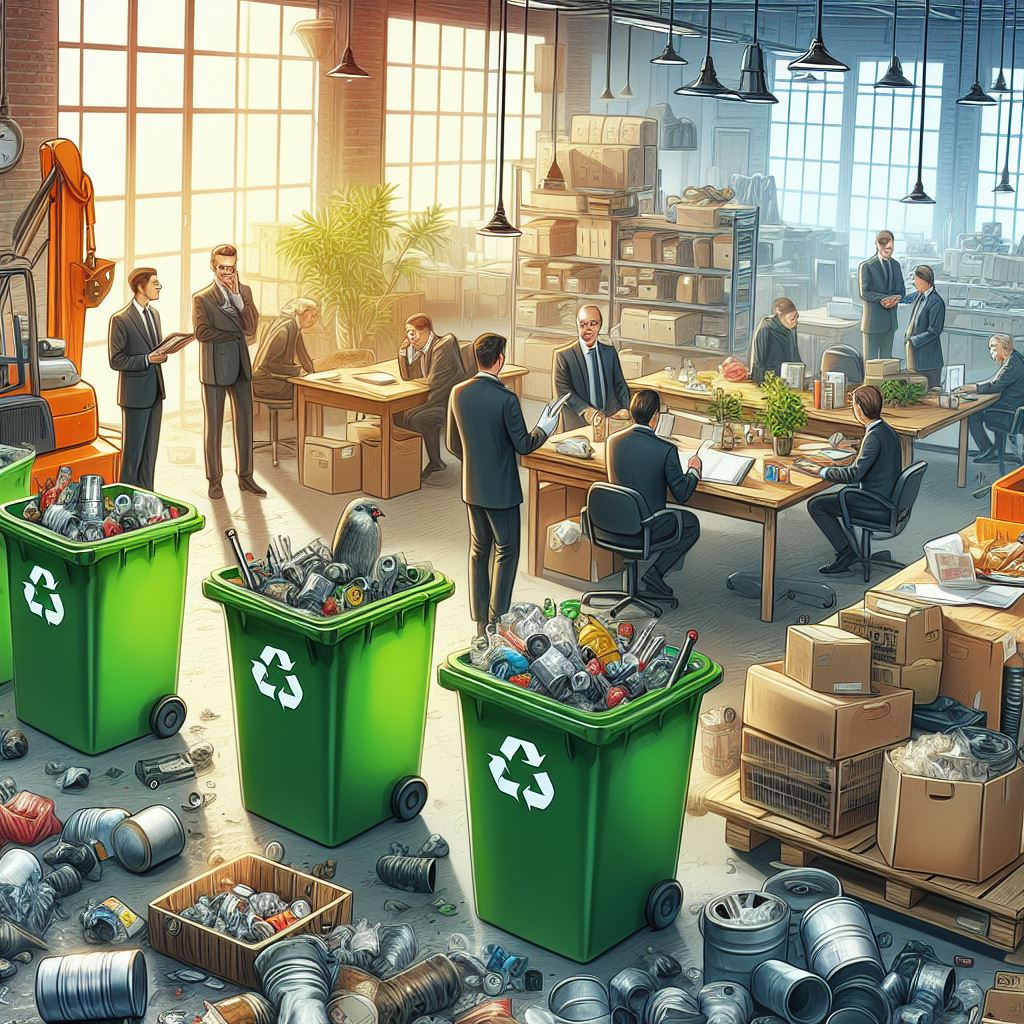Waste management in factories involves collecting, transporting, treating, and disposing of different types of waste. This includes solid waste, wastewater, hazardous waste, and emissions. Proper waste management helps comply with regulations and reduce risks to health and the environment. It can also cut costs by improving efficiency.
Importance of effective waste management in promoting sustainability and reducing environmental impact
Effective waste management is key to promoting sustainability in factories. By minimizing waste generation, recycling materials, and implementing energy-efficient processes, factories can reduce their carbon footprint and conserve valuable resources. This benefits the environment and improves operational efficiency, leading to cost savings in the long run.
Furthermore, responsible waste management helps factories comply with environmental regulations and demonstrate their commitment to corporate social responsibility. Factories benefit by prioritizing sustainability and reducing environmental impact. This helps enhance reputation, attract environmentally conscious customers, and gain a competitive edge in the market.
Current Practices in Waste Management
Factories commonly employ a variety of practices to manage their waste effectively.
- One common practice is the implementation of waste segregation, where different types of waste are separated into categories such as recyclables, organic waste, and hazardous materials. This allows for more efficient disposal methods and ensures that each type of waste is properly handled.
- Another common practice is the use of waste minimization techniques, where factories aim to reduce the amount of waste produced in the first place. This can include implementing more efficient production processes, using reusable materials, and encouraging employees to be mindful of their waste generation.
- Furthermore, many factories also utilize waste-to-energy technologies, where certain types of waste are converted into energy through processes such as incineration or anaerobic digestion. This not only helps to reduce the volume of waste being sent to landfills but also provides a valuable source of renewable energy for the factory.
Overall, these common practices in waste management help factories to reduce their environmental impact, comply with regulations, and improve overall sustainability.
Challenges and limitations faced by factories in managing waste effectively
Despite efforts to improve waste management practices, factories still face several challenges and limitations in effectively managing their waste.
- One major challenge is the cost associated with implementing advanced waste management technologies and systems. Many factories may struggle to justify the upfront investment required for these solutions, especially if they do not see immediate returns.
- Another challenge is the lack of infrastructure and resources in certain regions, which can make it difficult for factories to properly dispose of their waste. In some cases, factories may have limited access to recycling facilities or may be located in areas where landfill space is scarce.
- Additionally, regulatory hurdles and compliance issues can pose challenges for factories in managing their waste effectively. Ensuring that waste is disposed of in accordance with local regulations can be a complex and time-consuming process, especially for factories operating in multiple jurisdictions.
Best Practices for Waste Management in Factories
Implementing a plan
To effectively manage waste in factories, it is crucial to develop and implement a comprehensive waste management plan. This plan should outline specific strategies and procedures for minimizing waste generation, segregating different types of waste, and ensuring proper disposal methods are followed. By having a structured plan in place, factories can significantly reduce the amount of waste they produce and improve overall sustainability efforts.
Segregation of waste for recycling and proper disposal
One of the key pillars of effective waste management in factories is the segregation of waste for recycling and proper disposal. By separating recyclable materials from general waste, factories can divert a significant amount of waste from landfills and promote environmentally-friendly practices. Implementing clear labeling and designated bins for different types of waste can help streamline the segregation process and encourage employees to actively participate in recycling efforts.
Training and educating employees on waste management practices
In order for a waste management plan to be successful, it is essential to provide adequate training and education to employees on proper practices. By raising awareness about the importance of waste reduction, segregation, and recycling, employees can play a crucial role in implementing sustainable waste management practices within the factory. Regular training sessions and informational materials can help reinforce these principles and ensure that all staff members are on board with waste management initiatives.
Monitoring
To measure the effectiveness of waste management practices in factories, it is important to establish a system for monitoring and tracking waste generation and disposal. By keeping records of the amount and types of waste produced, factories can identify areas for improvement and implement targeted solutions to reduce waste. Regular inspections and audits can also help ensure that waste management protocols are being followed correctly and that any deviations are promptly addressed. By establishing a culture of accountability and continuous improvement, factories can strive towards achieving optimal waste management outcomes.
Examples
Some example company has adopted a comprehensive waste management system that includes recycling, composting, and proper disposal of hazardous materials. By segregating waste at the source and implementing strict protocols for waste handling, this company has significantly reduced its waste output and increased its recycling rates.
Another notable example is some electronics manufacturer, which has invested in advanced technologies such as waste-to-energy systems and closed-loop recycling processes. By closing the loop on its production cycle, company has not only reduced its environmental impact but also cut costs associated with waste disposal. This innovative approach has made this company a leader in sustainable manufacturing practices.
Benefits
The implementation of effective waste management practices in factories like this above, has resulted in a number of significant benefits. Firstly, these factories have seen a reduction in their overall waste generation, leading to cost savings in waste disposal fees and landfill taxes. By recycling and reusing materials, these companies have also reduced their reliance on virgin resources, contributing to a more sustainable supply chain.
Additionally, effective management has helped improve the reputation of these factories among consumers and stakeholders. By demonstrating a commitment to environmental stewardship, Mentioned companies have enhanced their brand image and attracted environmentally-conscious customers. This positive perception has also translated into increased business opportunities and partnerships with other eco-friendly organizations.
New Technologies and Tools for Waste Management
- Smart Bins – Smart bins are equipped with sensors that can detect when they are full, optimizing waste collection schedules and reducing overflow.
- Waste Sorting Robots – These robots use AI technology to quickly and efficiently sort different types of waste, increasing recycling rates and reducing contamination.
- Data Analytics – Utilizing data analytics can provide insights into waste generation patterns, allowing for more effective waste reduction strategies.
- IoT-based Monitoring Systems – Internet of Things (IoT) devices can monitor waste generation in real-time, helping factories track their waste production and make informed decisions.
- Cluer – an employee suggestion system identifying areas where waste can be reduced.
- XSAVERIO – a system monitoring media consumption and alerting about norm violations, making it easy to identify sources of excessive consumption.
Benefits of Implementing Advanced Waste Management Solutions
Cost Savings
By optimizing waste collection and recycling processes, factories can save money on waste disposal fees and reduce waste management costs.
Environmental Impact
Implementing advanced waste management solutions can help factories reduce their carbon footprint and contribute to a more sustainable future.
Compliance with Regulations
Meeting regulations is essential for factories to avoid fines and penalties, and advanced tools can help ensure compliance.
Increased Efficiency
By streamlining waste management processes with new technologies, factories can improve overall efficiency and productivity.
Regulations and Compliance for Waste Management in Factories
Understanding the regulatory landscape
- Factories must adhere to various local, state, and federal regulations when it comes to managing waste.
- Regulations may include guidelines on proper disposal methods, recycling procedures, and reporting requirements.
Environmental impact assessments
- Factories must conduct environmental impact assessments to determine the potential effects of their practices on the surrounding environment.
- This may involve analyzing air and water quality, soil contamination, and overall ecological impact.
Compliance with industry-specific regulations
- Certain industries may have specific regulations pertaining to waste management due to the nature of their operations.
- It is important for factories to stay informed about industry-specific regulations and ensure compliance.
Steps for ensuring compliance with local, state, and federal regulations
1. Conducting regular audits:
- Factories should conduct regular audits of their waste management practices to ensure compliance with regulations.
- Audits can identify areas of improvement and help prevent potential violations.
2. Training and education:
- Providing training to employees on proper practices is essential for compliance.
- Employees should be aware of regulations and standards to ensure they are followed correctly.
3. Implementing a waste management plan:
- Factories should develop a comprehensive waste management plan that outlines procedures for handling, storing, and disposing of waste.
- The plan should address various types of waste generated by the factory and include strategies for reducing waste generation.
4. Monitoring and reporting:
- Factories must monitor their waste management practices regularly to ensure compliance with regulations.
- Reporting requirements may include documenting waste generation rates, disposal methods, and any incidents of non-compliance.
By following these steps, factories can effectively manage their waste in compliance with local, state, and federal laws by staying informed about regulations.
5 Best Practices in Waste Management for Manufacturing Companies - Infographic (free to share)
Are you looking to improve your waste management practices in manufacturing? Download our infographic on the 5 best practices in waste management for manufacturing companies to learn how to reduce waste, save costs, and boost sustainability. Discover actionable strategies and tips to streamline your waste management processes and make a positive impact on the environment.

Values
Discover the benefits of collaboration
We offer a free consultation as the first step of collaboration, allowing you to familiarize yourself with our approach and verify our advisory competencies. This way, even before making a decision, you’ll feel that your situation and problem have been well understood, and the proposed solution will be optimally tailored to your company’s situation.
Our services (support) are included in a subscription, which does not generate hidden costs. The subscription-based billing allows for a significant reduction in the entry threshold into the system and enables immediate testing.
We are communicationally independent – we can develop our system without depending on the client’s IT department. We do not generate additional work for the client’s IT department. This way, we lower the implementation risk and associated costs. The possibility of quicker implementation of the solution results in faster return on investment.
Login to our applications is secured at a high level, characteristic of banking solutions. At the same time, the login process is intuitive. Your data is as secure as in a bank thanks to our system.
We offer multilingualism in our solutions through real-time translation—each employee operates applications in their native language. This enhances efficiency and reduces costs by expanding the potential labor market and eliminating the need to hire translators.
Our software features an interface optimized for quick, easy, and intuitive use, even by digitally excluded or poorly skilled employees. This means real-time savings in both time and training costs for your workforce in using the new software. The ability for rapid deployment of software for use results in a shorter transition/implementation period.

















